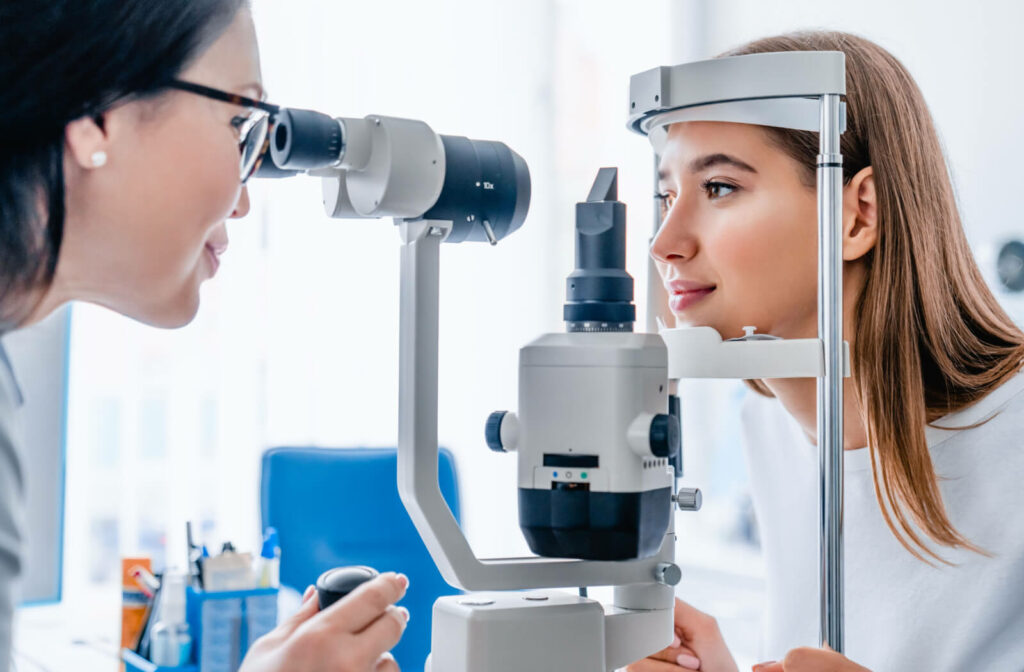Going to the optometrist isn’t only about picking your next pair of eyeglasses or getting fitted for contact lenses. An eye exam is one of the most important things a person can do to maintain their eye health and vision.
Routine eye exams allow eye doctors to detect, diagnose, and treat various common, vision-impairing conditions. Knowing what to expect and the tests included is one way to be proactive in your ocular health.
Eye Exam Frequency
Age, general health, and risk of developing eye problems determine the frequency of eye exams.
Children’s routine eye exams can help detect common eye conditions, such as refractive errors, strabismus, or amblyopia. For children, the American Optometric Association recommends the following:
- Birth to age 2: At least one exam
- Age 3 to 5: At least one exam or as recommended
- Age 6 to 17: Annual eye exams
For adult patients, the American Optometric Association recommends the following:
- Age 18 to 39: At least one exam every two years. For high-risk, annually or as recommended
- Age 40 to 64: At least one exam every two years. For high-risk, annually or as recommended
- Age 65 and older: Annually and for high-risk, annually or as recommended
Certain factors can put you at a higher risk and necessitate more frequent examinations. These factors can include:
- Family history of eye disease
- A high or progressive refractive error
- A medical condition with potential ocular manifestations, for example, diabetes
- Taking medication that has visual side effects
- Wear contact lenses
- Functional vision in only one eye
- Have an occupation that is visually demanding or hazardous to your eyes
What to Expect at a Routine Eye Exam
Routine eye exams are clear-cut and can include questions about your health, medical history, and lifestyle. Remember to bring your current pair of glasses or contacts with you. Common questions may include the following:
- Do you have eye problems?
- Do you have a family history of eye conditions?
- Have you had eye problems in the past?
- Do you wear glasses or contacts? Are they comfortable?
- Do you have any health problems?
- Do you take any medications?
- Have you had eye surgery?

Routine Eye Exam Tests
Many eye diseases and conditions develop without any noticeable signs or symptoms. Routine eye exam tests can screen for these before they progress or cause vision impairment. Routine eye exam tests can include the following:
Visual Acuity
Visual acuity measures your ability to focus on an object at a given distance. It is determined by how well you can read numbers or letters on an eye chart with one or both eyes.
Refraction Test
Using a computerized refractor or by shining a light into your eyes, your eye doctor can assess how light reflects off your retina. If there’s a refractive error, such as nearsightedness, farsightedness, or astigmatism, a phoropter determines the prescription.
Glaucoma Test
Tonometry measures pressure inside the eyes also called intraocular pressure. High eye pressure is a risk factor for glaucoma. Part of glaucoma testing includes visual field testing to check peripheral or side vision.
Cataract Test
A slit lamp exam allows the eye doctor to view the eye from front to back. By magnifying and lighting the eye, they can view the cornea, iris, lens, and back of the eye to detect cataracts and macular degeneration.
Pupil Dilation
Dilating the pupil allows the eye doctor to view the retina and optic nerve. Eye drops cause the pupils to enlarge and more light to enter to view the eyes better. You can experience sensitivity to light or blurry vision after. Wear sunglasses and have someone drive you home as the effects wear off after a few hours.
Diabetic Eye Exam
For patients with diabetes, an annual diabetic eye exam helps monitor eye and visual health. If you have diabetes, you are at increased risk of developing an eye condition called diabetic retinopathy.
Eye Exams for Visual Health
The main goal of an eye exam is to identify any problems before they progress too far and to begin treatment. It can help prevent further vision loss.
If you have eye pain, blurred vision, or notice changes in your vision, an eye exam and further tests may be required. Contact Griffin Optometric Group to book your next routine eye exam appointment.



